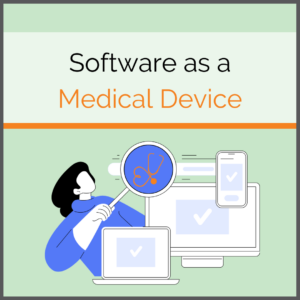
Software as a Medical Device (SaMD) is a collective term for software used for medical purposes. SaMDs exist as stand-alone products and as parts of other medical devices. Their legal definition varies from country to country. For example, the Medical Device Regulation (MDR) defines them as follows: Software intended to be used alone or in combination for a purpose specified in the definition of a medical device in the MDR or IVDR.
This definition means that a SaMD is considered a medical device if its intended purpose is medical. Included are, for example, the diagnosis, treatment, or monitoring of diseases and injuries. However, some questions remain unanswered. How do I determine a Software as a Medical Device? What types of SaMDs are there? And what does the future hold for Software as a Medical Device? This article aims to answer these questions.
What types of SaMD are there?
You can divide Software as a Medical Device into two different types. The distinction is between stand-alone and embedded SiMD (Software in a Medical Device). However, this is not an official classification. The distinction relates only to the intended use. Since embedded SiMDs do not exist as independent medical devices, their manufacturers do not have to assign them a UDI.
- Stand-alone SaMD is software used as a stand-alone medical device. Examples of stand-alone SaMDs are digital health applications, so-called Digital Health Apps. They are often used for self-diagnosis or self-treatment of diseases.
- Embedded SiMD is software that is integrated into another medical device. Examples of embedded SiMDs are the control software of pacemakers or the image processing software of X-ray devices.
How do I determine a SaMD?
Unfortunately, the MDR definition does not provide any further guidance on the classification of computer programs as SaMD. For this reason, the COCIR has published a flowchart for determining a SaMD. In six steps, it is established whether the software in question is a medical device, a component of a medical device, or neither.
- Is the software a computer program? If this is not the case, the software is a digital document and therefore not a SaMD. If it is the case, it may be a SaMD, and you can move on to point two.
- Is the software an integral part of medical equipment? If this point applies, the software is part of a SaMD. If this is not the case, move on to the third point, as the software may be a stand-alone SaMD.
- If the software drives a medical device, monitors its performance, or exerts any other influence on it, it is a SaMD. Accordingly, the software requires CE certification. If this point does not apply, proceed to point four.
- If the software has no effect on the data of the medical device or is limited to storage, archiving, communication, or a simple search function, it is not a medical device. In other cases, e.g. if the software modifies the presentation of data for a medical purpose, it could be a medical device.
- If the software performs an action that relates to individual data of patients (whether anonymized or not), it could be a SaMD. Otherwise, it is not.
- If the software acts on data (relating to individual patients) that is intended by the manufacturer to be used for medical purposes, it is a SaMD. If this point does not apply, it is not a SaMD.
The flowchart can be viewed here for illustration purposes.
What does the future of SaMDs look like?
SaMDs have the potential to fundamentally change healthcare. They help to make it more efficient and cost-effective. They will also be used to improve the treatment of diseases and give patients more autonomy and control over their health. In the future, SaMDs are expected to play an increasingly important role in healthcare. People who live in places with a lack of healthcare can benefit in particular. Smartphone apps are already being used to help with examinations. SaMDs will open new possibilities for the prevention, diagnosis, and treatment of diseases. For example, artificial intelligence is getting better and better at helping doctors make diagnoses. Research has shown, that when mammograms were read by artificial intelligence, the detection rate for breast cancer was 4% higher than after evaluation by radiologists. As AIs continue to develop and improve, it is expected that they will continue to further gain relevance, particularly for diagnostic purposes.
Do you need help registering your SaMD or with other MDR-related topics? Contact us here. We will be happy to support you.
[Disclaimer] This information is only one possible interpretation of the regulations. They are also in a constant state of change, so the information in this article may be incomplete or out of date. The above article is expressly no legal advice. Please refer to the official documents for information before making any business decisions. (Status of information: January 2024)